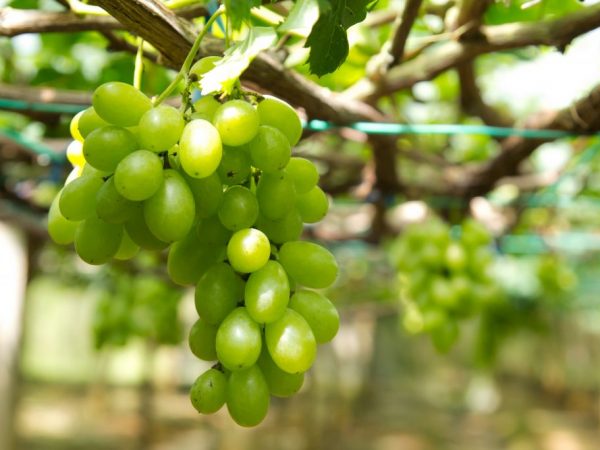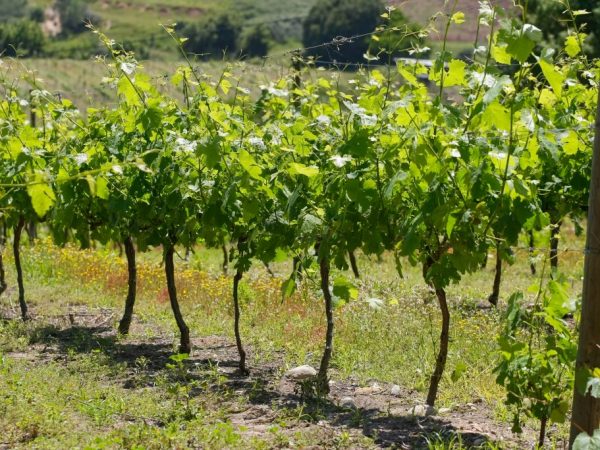Description of the First-Called grapes
The first-called grape is obtained by crossing the Talisman and the radiant Kish-Misha. Due to its quality characteristics, it quickly won the love of professional and amateur winegrowers.

Description of the First-Called grapes
Characteristic
The first-called grape variety belongs to the table, hybrid, very early, with a highly developed vine. It was bred in Russia in 1989 by the breeder V.N. Krainov. The harvest ripens early. The cultivation of the first-called grapes is possible in the southern and northern regions of the country, in greenhouses and on open soils. The ability of the First-Called grapes to withstand frost down to -25 ° C allows harvesting in the northern regions, no worse than in the southern ones. The berries ripen on day 115-120, after bud break. Ripe harvest is harvested from mid-August.
Description of the tree
Bisexual bushes. Grape clusters are cylindrical in shape. According to the description, their weight reaches 750 g. Leaves are beautiful green, heart-shaped.
Description of fruits
Description of grape berries:
- average density per bunch;
- each weighing up to 10 g;
- balanced sweet taste with pleasant floral notes;
- the pulp is juicy, fleshy and homogeneous;
- high sugar content (21%);
- the color of the berry is amber.
Growing varieties
Landing
It is better to plant the first-called grapes away from other garden plants so that they do not interfere with its growth and development. This grape is unpretentious to soils, it grows well on loam and super-sandy soil. Loves the sun and warmth, this must be taken into account when choosing a landing site. On the site, it is better to choose the south side, on a hill, so that the soil water does not approach the roots.
You can plant the plant in early spring, before the start of sap flow or in late autumn.
The pit is dug 70x80 cm and up to 70 cm deep. Organic fertilizer is poured to the bottom. A seedling is installed and watered abundantly with water, at room temperature. This will speed up the survival rate.
All surface roots are buried in, sprinkled with a nutritious soil mixture so that they do not die and do not destroy the entire bush. In the first years of life, seedlings need such a procedure especially. The young plant has not yet matured, and in the first frosts it can freeze. Drought also adversely affects bare young roots, dries them out. It is better to deepen the surface roots into the soil in the summer in the morning, before the onset of heat.
Watering and fertilizing

Prevent the soil from drying out
To obtain a good harvest of the first-called grapes, proper care is provided. Loosen the soil at the root zone regularly and get rid of the grass. Monitor the moisture content of the ground, avoiding drying out. For watering, a hole is made around the bottom of the vine.
Watering is regulated by the weather. 10 liters of water per bush per month. Care is required during the entire growing season. No watering or fertilization is required before harvest and during flowering.
Organic and mineral fertilizers are applied under the grapes together with watering 3 times per season.In summer and spring, Biopon is used, which contains a lot of nitrogen. Nitrogen stimulates the growth of vines and foliage. From the second decade of June, potash-phosphorus fertilizers are introduced into the root zone. They are diluted in water or scattered with granules before watering. For a stable harvest, compost is applied every 2 years.
Pruning
Pruning is essential for proper bush formation and good fruiting. In the spring, shoots are removed so that no more than 25-30 eyes remain on the bush. Dried branches are pruned in late autumn, in pre-winter preparation.
Diseases and prevention
The Pervozvanny grape variety is resistant to many diseases. However, from bad weather or soil conditions, grape bushes get sick with viral and fungal diseases, which include anthracciosis, white and gray rot, powdery mildew, etc.
To be sure of the health of the vineyard, preventive measures are taken. For this, spraying with copper sulfate, fungicide and a mixture of Bordeaux is carried out.
To protect against wasps, which also harm the crop, place a container with sugar syrup and poison near each bush. Wasps flock into it, and the berries remain intact.
Conclusion
It is not difficult to get a tasty and healthy harvest of grape berries if you follow simple rules. For the time and effort spent, the plant will thank you with ripe amber bunches.


